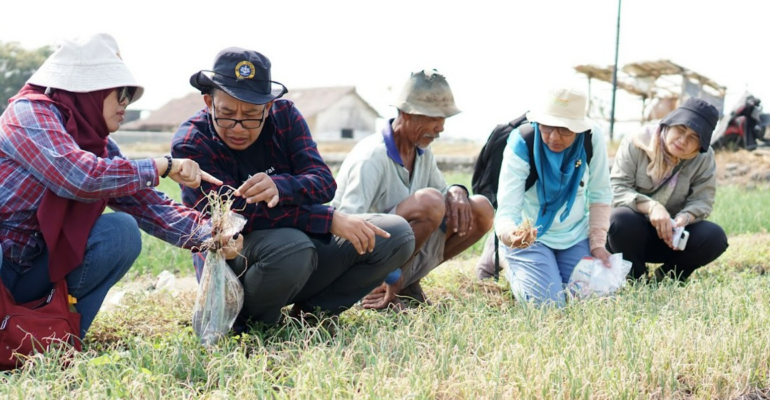Gurem Pests and Janda Pirang Threaten Shallot Farmers, IPB University Deploys Expert Team

In the midst of onion prices that have not yet improved, gurem pests have added to the suffering of farmers in onion centers such as Brebes, Nganjuk, and Kulonprogo.
Responding to this, the Department of Plant Protection, Faculty of Agriculture, IPB University deployed a team of Plant Clinic experts on Wednesday (11/10) to Friday (13/10) to Brebes and Tegal, Central Java. This field investigation will be continued to other onion centers such as Nganjuk and surrounding areas in the following week.
The pest, which is the first time farmers have complained about this planting season, is estimated to cause losses of more than 60 percent if it attacks onions aged around 35 days. In fact, the pest attack can cause losses of up to 100 percent if it occurs earlier at around 25 days of age.
Chairman of the IPB University Plant Clinic, Bonjok Istiaji SP, MSi explained that the team’s findings in the field showed that what is meant by gurem or mreki is probably the thrips insect. This pests measuring approximately 1 millimeter in length is indeed very high in population in onions with yellowing and drying symptoms as if the plants lack water.
“This symptom is observed in 35-40 day-old onions. The symptoms are evenly distributed and the plants can no longer live so they are forced to be harvested young with the economic value dropping to less than a third of normal conditions,” he explained.
Despite this, the team of experts is still not fully convinced that thrips are the cause of the so-called gourmand symptoms. “It is true that the thrips population is very high in symptomatic plants, more than 100 individuals per onion clump. But there are other symptoms that are not typical thrips symptoms. So it could be that thrips came after the plants were damaged, aka secondary invasion,” explains Bonjok Istiaji, who is also a member of the expert team.
Another possibility is that the thrips are vectors of pathogens, such as viruses or fungi, so the attack is indeed quite heavy and evenly distributed.
“What is clear is that this is the first time onion farmers have faced this problem in Indonesia. We will take a number of samples to the laboratory at IPB University for further research,” he said.
Dr Dewi Sartiami, another member of the expert team, said that the thrips found in the field are morphologically different from the thrips species commonly found on onions, Thrips tabaci. “We will confirm the species again in the laboratory with more adequate equipment, including molecular identification,” she added.
Not finished with the gourmand pests, Brebes farmers are also complaining about an onion disease they call blonde widow. The symptom is simultaneous yellowing of the leaves, but the bulbs do not rot.
After confirmation in the field, thrips populations were also found on plants with symptoms of blonde widow. Thus, the IPB University expert team tentatively suspects that janda pirang peats disease is related to thrips pests.
However, the infected plants in Brebes were younger, about 25 days old and had not yet formed bulbs, so the loss could reach 100 percent or puso because the onions could not be harvested.
During the three-day field investigation, a team of IPB University Plant Clinic experts visited onion plantations in Wanasari and Jatibarang sub-districts in Brebes and Dukuhwaru sub-district in Tegal. The team, consisting of a number of lecturers from IPB University’s Plant Protection Department, are experts in insects, viruses, fungi, nematodes and bacteria.
The expert team is also working with the Directorate of Horticultural Plant Protection, Ministry of Agriculture and IPB University’s network of partner farmers. In addition to going directly to the field together, a number of onion samples are also being sent from Nganjuk and Kulonprogo both by plant pest control officers and farmer groups to IPB University for further research.
Dean of the Faculty of Agriculture of IPB University, Prof. Suryo Wiyono said, “This activity is a tradition of IPB University, especially the Faculty of Agriculture, to always be present and not let farmers struggle alone. After field investigation and quick analysis in the laboratory, the team will immediately formulate recommendations for control and other steps that need to be taken, of course by involving related agencies.”
Within a month, he expects a number of dissemination media containing the formulation of recommendations and policy briefs to be completed. This can be used as a reference for policy makers, especially in the agricultural sector. “Universities should be part of the solution to problems in the field,” concluded Prof Suryo. (*/Rz) (IAAS/RUM)



